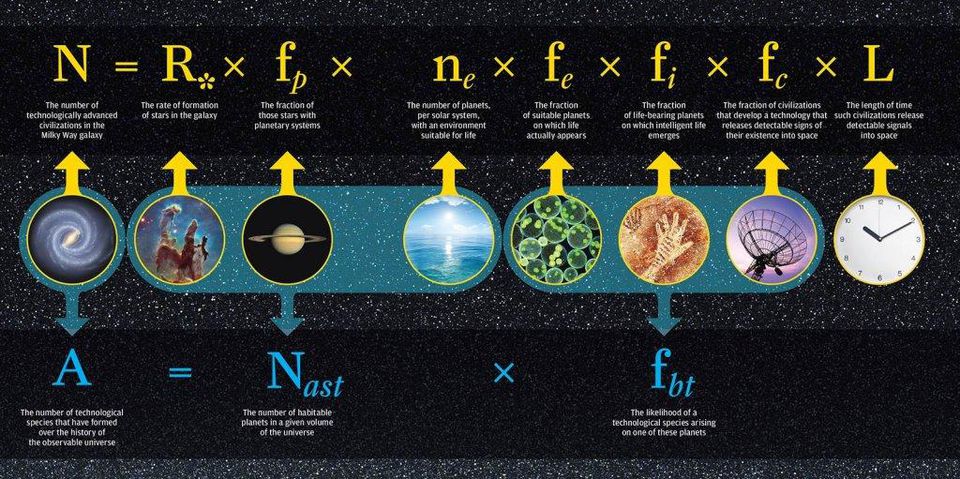
A NOTE FIRST: MERCURY TURNS DIRECT AT 1: 26 am PDT, 4:26 am EDT!! YAY!
Above is the Drake equations: the first first equation to attempt to quantify how many alien civilizations might be present in our own galaxy today.
When mainstream scientists talk about space aliens, they’re referring to any intelligent beings who might be living in far, far, far off civilizations. They don’t talk about any such aliens being just around the corner, so to speak, or abducting your neighbors. That’s for the ufologists and fans of the ancient alien scenario.
So it’s interesting when scientist analyze the Milky Way and tell us that at the very minimum there are probably at least 36 civilizations in existence…out there.
They are cited in an article in Forbes.com, noting that “even if we consider that many of these worlds may be false positives, more like mini-Neptunes than Earth, or otherwise uninhabitable for a variety of reasons, there are still at least billions of planets that have properties analogous to Earth in our Milky Way right now.”
Looking at it from that perspective, the 36 civilizations seem pretty puny, indeed.
Scientist tracking the likelihood of alien civilizations also tend to look at the creation of life as the result of random mix of microbes gradually evolving, and gradually forming creatures with intelligence life. What are the chances, right?
According to article author Ethan Seigel: “It’s kind of ironic, then, that just a few weeks ago, a very responsible paper was written, highlighting what you should be able to infer about life in the Universe based on what’s arisen on Earth. We know what the early conditions on Earth were and how often similar conditions appear to arise in our Universe, and we understand how statistical inference works, so putting those pieces of information together allows us to learn what the most likely outcomes are if we were to turn back the clock and start over with a “young Earth” in the early Solar System.
“That paper found that it’s very likely that life arises frequently in the Universe, but that it’s more likely than not that intelligent life is rare. The confidence levels on those findings are not very good but the best we have, which is what you’d expect given a successful sample size of one: Earth alone.”
The so-called ‘very responsible papers,’ of course are ones based on randomness and statistics – as espoused above – but not higher awareness. That said, others exploring on the frontiers of science are looking at consciousness itself preceding physical matter, not being created as a result of it. Therefore, things might not be quite so random, as mainstream scientists suspect. Hopefully, someday those scientists exploring the frontiers of science as well as the frontiers of the universe will also be writing ‘very responsible papers.’








Alien civilizations wouldn’t necessarily have to rise from “earthlike” conditions. Other lifeforms could be nitrogen based instead of carbon based, as one example. Their planets would be uninhabitable by our standards. Life and civilization could still thrive. In reference to the above equation, we can’t define “suitable planets.”
Good point!